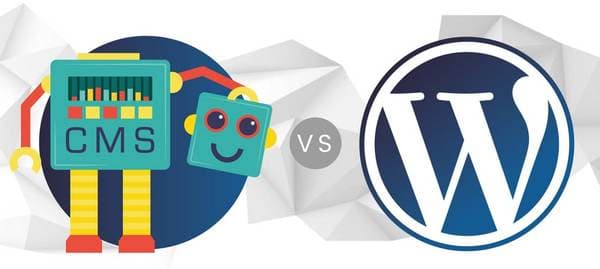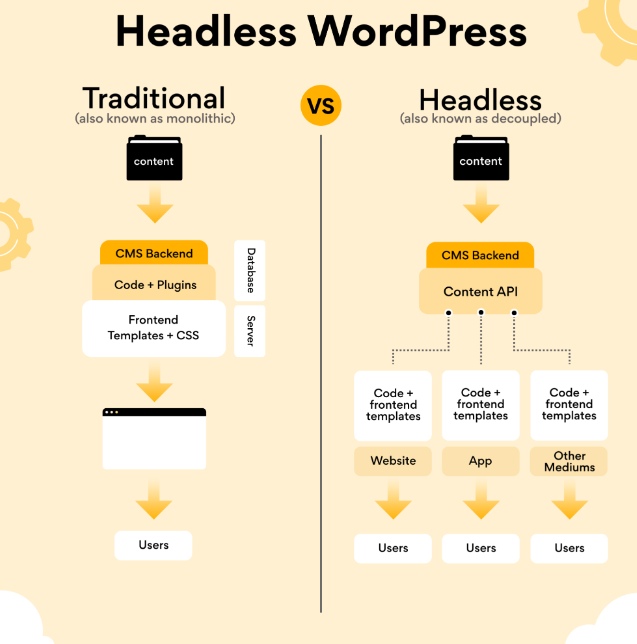
Headless WordPress vs. Traditional WordPress: Which One Is Right for You?
Did you know that WordPress powers more than 42.6% of the internet? Given that WordPress offers everything a webmaster with minimal technical experience needs to develop and manage a fully functional website, this is not surprising. Yet, in the current market, business websites must be created and managed with more flexibility, performance, and security. Thankfully, headless WordPress can help with that.
What Does Headless Mean?
To put it simply, headless implies implementing a best-in-class API design and "decoupling" the front end and back end. You are separating the presentation layer where the content is displayed from the repository where it is saved.

Distribution of the output is possible to various heads, such as mobile apps, store displays, and online sites. This makes it possible for you to concentrate more on delivering outstanding customer service, regardless of how customers choose to interact with your goods.
What is Headless WordPress?
Headless WordPress refers to any website that uses WordPress as the back-end content and data management system but other front-end technologies to display the data. The admin section of a website is referred to as the back-end. Here is where you add plugins, handle comments, and publish content like posts and pages. Both aspects are often taken care of by WordPress, a powerful software. Every WordPress theme can be used to display your website.
To design a unique front-end for their website, some developers and website owners may need to use React.js and other technologies, depending on their requirements.
Headless Although still using WordPress in the backend for simpler content management, WordPress enables them to employ such technologies.
What is a Headless WordPress Site?
It's important to recognize that WordPress is a strong and frequently helpful platform for website construction. Its CMS is unparalleled, making it a trustworthy and user-friendly tool for all of your content-related demands.
But, it can be a little lacking when it comes to developing the remainder of your website. WordPress can be customized, but because of its reliance on themes, it is somewhat constrained. There are several WordPress themes available that can give your website some structure and functionality, but they are rather constrained by what has already been done.
This is where a headless WordPress development serves a purpose. A headless CMS, or CMS that has been decoupled from its normal architecture, is an extension of a headless WordPress site.
A headless CMS enables you to preserve the same back end but access it through an application programming interface (API) or software development kit. A CMS is your back end, and it's typically combined with a front end — the part that website visitors see — built to operate with it (SDK). This enables you to maintain a functional and well-known CMS while creating a totally customized site that meets your demands.
With a headless WordPress site, you can keep and manage the WordPress back end alongside your website. To facilitate this, WordPress developers established the Rest API back in 2016.
WordPress as Headless CMS
The implementation of a headless CMS is the best approach we can provide. As a headless CMS, WordPress lacks a front end. As a result, it only contains the API and back-end elements needed to manage content, store data, and manage workflow, such as in the case of developing mobile applications.
A headless CMS pushes content to any system via APIs. Similar to this, numerous frameworks can be used in your projects, and you can rely on a headless CMS design to push content to diverse platforms. Content creators can develop, format, schedule, and publish material using a headless WordPress.
Why Headless CMS WordPress is Gaining so Much Popularity?
Website development using the headless method is new. Headless WordPress was developed by Automattic to improve the scalability, usability, and speed of WordPress. WordPress is a potent CMS that can be used to create websites. It is open-source and simple to use. The issue is that scaling WordPress can be challenging when the site expands and therefore slows down.
Headless WordPress's major objective is to enable the development of unique solutions that are not constrained by the conventional WordPress architecture while utilizing WordPress's sizable developer community and a user-friendly backend. Further advantages of headless WordPress include greater speed, flexibility in design, and the opportunity to reuse code and content.
By including security measures and smooth connectivity with third-party services, which are crucial to digital marketers, Headless is future-proofing WordPress. With headless WordPress, you can maintain the speed and security of your website without sacrificing any of the beloved WordPress features.
Headless Architecture
Both the front end and the back end are distinct in a headless CMS system. Hence, a connection is required for communication between the client-side web application and the server-side content management system. The application-side interface (API) enters the picture in this situation. A standardized method for software to connect with one another is the API. Headless CMSs are sometimes known as API-first CMSs because of how important APIs are to them.
WordPress makes use of a REST API, a web-based API that enables the usage of endpoints, or HTTP web addresses, for communication over the internet. Endpoints accept various kinds of queries from the API and resemble the web addresses we use to access websites.
Advantages of a Headless CMS
Enhance omnichannel content publishing by simplifying it
Publishing material on several platforms is simple. You may manage and publish content on several channels, including as websites, applications, and social media, using automation in headless WordPress. It improves the digital experience for your clients while freeing up staff time for important activities.
Learn about new content formats
The range of possibilities is increased with a headless CMS. Without being constrained by the limited front-end content formats, you can abandon HTML and use JavaScript as you see fit. That is why creating online and mobile apps using headless WordPress is growing in popularity.
Scalability can be achieved quickly
You can manage content from a single source and distribute it to several channels thanks to a headless CMS. You can change developer tools whenever you want in accordance with your needs and the resources that are accessible because the back end is independent.
Boost the speed of your website
Headless WordPress makes it easier for users to load websites onto their devices. First, because the front end and back end are separate, the website takes fewer resources (just the front end) to load. Second, there is no time lag brought on by installed plugins, which would ordinarily slow down web pages.
Headless WordPress speeds up your website as a result. Search engine optimization (SEO) initiatives are recognized to profit from websites that load quickly.
Take advantage of flexibility and functionality
Developers are allowed to select a front end that supports a programming language they are familiar with because the content is supplied over APIs using a headless CMS.
Final thoughts
Although I think headless is the way of the future, I don't think traditional WordPress will disappear because of it. It won't change that a sizable portion of the WordPress user base consists of non-developers who aren't interested in detaching their content management system.
For enterprises with the developer muscle, the experience, and the resources to create custom digital experiences at scale, headless technology is and will remain a viable alternative. It's encouraging to see developers modifying the platform to accommodate new use cases now that WordPress is gaining popularity as a workable headless CMS.
If you have what it takes to go headless, do it. Make sure you're doing it for the correct reasons before you commit to it. You won't regret it, and you won't go back.
Do you want secure, fast website or application?